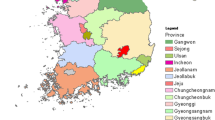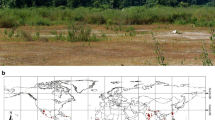Abstract
Galinsoga quadriradiata, an annual herbaceous plant originating in Central and South America, has caused great harm to agriculture and natural communities in China recently. However, the distribution and influence of this invader are poorly documented. It is also unclear how climate change will affect the expansion of G. quadriradiata. In this study, we built a series of maximum entropy (Maxent) models to predict the potential distribution areas of G. quadriradiata under current and future (2030s, 2050s, and 2080s) climatic scenarios using six uncorrelated bioclimatic variables (obtained from the fifth report of the IPCC) and 274 occurrences. The Maxent model obtained high AUC value of 0.960, and the prediction showed that highly suitable areas for G. quadriradiata mainly locate in central, eastern, southwestern, and southern China. In the context of climate change, its suitable area will tend to contract in the future and disappear in southern and eastern China, but will expand in northeastern China. Overall, by the end of the century, its suitable area will be reduced by 12.1% and move northward in China. Our study suggests that G. quadriradiata has high invasive potential currently; however, to some extent, ongoing climate change will inhibit its expansion in China. In addition, the invasion risk of G. quadriradiata in northeastern China will continuously increase, keeping pace with global climate change in the coming decades, while the invasion risk in central, southwestern, and eastern China will stay continuously. Urgent preventative measures against G. quadriradiata invasion are necessary in these areas.




Similar content being viewed by others
References
Anderson RP, Martínez-Meyer E (2004) Modeling species’ geographic distributions for preliminary conservation assessments: an implementation with the spiny pocket mice (Heteromys) of Ecuador. Biol Conserv 116:167–179. https://doi.org/10.1016/s0006-3207(03)00187-3
Bellard C, Thuiller W, Leroy B, Genovesi P, Bakkenes M, Courchamp F (2013) Will climate change promote future invasions? Glob Chang Biol 19:3740–3748. https://doi.org/10.1111/gcb.12344
Bradley BA (2013) Distribution models of invasive plants over-estimate potential impact. Biol Invasions 15:1417–1429. https://doi.org/10.1007/s10530-012-0380-0
Bradley BA, Wilcove DS, Oppenheimer M (2010) Climate change increases risk of plant invasion in the Eastern United States. Biol Invasions 12:1855–1872. https://doi.org/10.1007/s10530-009-9597-y
Briga M, Verhulst S (2015) Large diurnal temperature range increases bird sensitivity to climate change. Sci Rep 5:16600
Brooks WR, Jordan RC (2013) Propagule pressure and native species richness effects drive invasibility in tropical dry forest seedling layers. Perspect Plant Ecol Evol Syst 15:162–170. https://doi.org/10.1016/j.ppees.2013.03.001
Byers JE, Smith RS, Pringle JM, Clark GF, Gribben PE, Hewitt CL, Inglis GJ, Johnston EL, Ruiz GM, Stachowicz JJ, Bishop MJ (2015) Invasion expansion: time since introduction best predicts global ranges of marine invaders. Sci Rep 5:12436. https://doi.org/10.1038/srep12436
Crooks JA (2005) Lag times and exotic species: the ecology and management of biological invasions in slow-motion. Ecoscience 12:316–329
Cubasch U, Meehl GA, Boer GJ, Stouffer RJ, Dix M, Noda A, Senior CA, Raper S, Yap KS (2001) Projections of future climate change. In: Houghton JT (ed) Climate change 2001: The scientific basis contribution of working group I to the third assessment report of the intergovernmental panel on climate change. Cambridge University Press, United Kingdom
Cui X, Bai H, Wang T (2013) Difference in NDVI with altitudinal gradient and temperature in Qinling area. Resour Sci 35:618–626
Elith J, Leathwick JR (2009) Species distribution models: ecological explanation and prediction across space and time. Annu Rev Ecol Evol Syst 40:677–697. https://doi.org/10.1146/annurev.ecolsys.110308.120159
Ficetola GF, Thuiller W, Miaud C (2007) Prediction and validation of the potential global distribution of a problematic alien invasive species—the American bullfrog. Divers Distrib 13:476–485. https://doi.org/10.1111/j.1472-4642.2007.00377.x
Fourcade Y, Engler JO, Rodder D, Secondi J (2014) Mapping species distributions with MAXENT using a geographically biased sample of presence data: a performance assessment of methods for correcting sampling bias. PLoS One 9:e97122. https://doi.org/10.1371/journal.pone.0097122
Garcia K, Lasco R, Ines A, Lyon B, Pulhin F (2013) Predicting geographic distribution and habitat suitability due to climate change of selected threatened forest tree species in the Philippines. Appl Geogr 44:12–22. https://doi.org/10.1016/j.apgeog.2013.07.005
He W, Bu R, Xiong Z, Hu Y (2013) Characteristics of temperature and precipitation in Northeastern China from 1961 to 2005. Acta Ecol Sin 33:519–531. https://doi.org/10.5846/stxb201111241799
Hijmans RJ (2015) R package raster: geographic data analysis and modeling, version 2.3–40. https://cran.r-project.org/web/packages/raster/index.html . Accessed 2 Mar 2016
Hijmans RJ, Cameron SE, Parra JL, Jones PG, Jarvis A (2005) Very high resolution interpolated climate surfaces for global land areas. Int J Climatol 25:1965–1978. https://doi.org/10.1002/joc.1276
Huang J, Huang J, Liu C, Zhang J, Lu X, Ma K (2016) Diversity hotspots and conservation gaps for the Chinese endemic seed flora. Biol Conserv 198:104–112. https://doi.org/10.1016/j.biocon.2016.04.007
Jueterbock A, Smolina I, Coyer JA, Hoarau G (2016) The fate of the Arctic seaweed Fucus distichus under climate change: an ecological niche modeling approach. Ecol Evol 6:1712–1724. https://doi.org/10.1002/ece3.2001
Kabuce N, Priede N (2010) NOBANIS-invasive alien species fact sheet Galinsoga quadriradiata. https://www.nobanis.org/globalassets/speciesinfo/g/galinsoga-quadriradiata-/galinsoga-quadriradiata.pdf. Accessed 1 April 2017
Kolanowska M, Konowalik K (2014) Niche conservatism and future changes in the potential area coverage of Arundina graminifolia, an invasive orchid species from Southeast Asia. Biotropica 46:157–165
Koo KA, Park SU, Hong S, Jang I, Seo C (2017) Future distributions of warm-adapted evergreen trees. Neolitsea sericea and Camellia japonica under climate change: ensemble forecasts and predictive uncertainty. Ecol Res. https://doi.org/10.1007/s11284-017-1535-3
Kunstler G, Thuiller W, Curt T, Bouchaud M, Jouvie R, Deruette F, Lepart J (2007) Fagus sylvatica L. recruitment across a fragmented Mediterranean Landscape, importance of long distance effective dispersal, abiotic conditions and biotic interactions. Divers Distrib 13:799–807. https://doi.org/10.1111/j.1472-4642.2007.00404.x
Lemoine NP (2015) Climate change may alter breeding ground distributions of eastern migratory monarchs (Danaus plexippus) via range expansion of Asclepias host plants. PLoS One 10:e0118614
Li C, Qi S, Yao J, Yang L (2015) Genetic diversity and differentiation of invasive plant Galinsoga quadriradiata populations in China. Chin J Ecol 34:3306–3312
Liu G, Zhang L, Kong B, Wei X, Zhu Z (2016) The population growth dynamic of Galinsoga quadriradiata Ruiz and Pav. on Qinling-Bashan Mountain. Acta Ecol Sin 36:3350–3361
Loarie SR, Carter BE, Hayhoe K, McMahon S, Moe R, Knight CA, Ackerly DD (2008) Climate change and the future of California’s endemic flora. PLoS One 3:e2502
Marcer A, Sáez L, Molowny-Horas R, Pons X, Pino J (2013) Using species distribution modelling to disentangle realised versus potential distributions for rare species conservation. Biol Conserv 166:221–230. https://doi.org/10.1016/j.biocon.2013.07.001
Midgley GF, Hannah L, Millar D, Thuiller W, Booth A (2003) Developing regional and species-level assessments of climate change impacts on biodiversity in the Cape Floristic Region. Biol Conserv 112:87–97. https://doi.org/10.1016/s0006-3207(02)00414-7
Mohammadi H, Karami M, Kiabi BH, Monavari S (2015) Assessing regional habitat changes for the Persian fallow deer (Dama dama mesopotamicus) using Maximum Entropy Modeling approach in Khouzestan province, Iran. Int J Environ Res 9:753–760
Padalia H, Srivastava V, Kushwaha SPS (2014) Modeling potential invasion range of alien invasive species, Hyptis suaveolens (L.) Poit. in India Comparison of MaxEnt and GARP. Ecol Inform 22:36–43. https://doi.org/10.1016/j.ecoinf.2014.04.002
Parks CG, Radosevich SR, Endress BA, Naylor BJ, Anzinger D, Rew LJ, Maxwell BD, Dwire KA (2005) Natural and land-use history of the Northwest mountain ecoregions (USA) in relation to patterns of plant invasions. Perspect Plant Ecol Syst 7:137–158
Pearce J, Ferrier S (2000) An evaluation of alternative algorithms for fitting species distribution models using logistic regression. Ecol Model 128:127–147
Pearson RG, Dawson TP (2003) Predicting the impacts of climate change on the distribution of species: are bioclimate envelope models useful? Glob Ecol Biogeogr 12:361–371
Peterson AT, Vieglais DA (2001) Predicting species invasions using ecological niche modeling: new approaches from bioinformatics attack a pressing problem. Bioscience 51:363–371. https://doi.org/10.1641/0006-3568(2001)051%5b0363:PSIUEN%5d2.0.CO;2
Phillips SJ, Anderson RP, Schapire RE (2006) Maximum entropy modeling of species geographic distributions. Ecol Modell 190:231–259. https://doi.org/10.1016/j.ecolmodel.2005.03.026
Phillips SJ, Dudík M, Elith J, GrahamCH Lehmann A, Leathwick J, Ferrier S (2009) Sample selection bias and presence-only distribution models: implications for background and pseudo-absence data. Ecol Appl 19:181–197
Pyšek P, Richardson DM (2010) Invasive species, environmental change and management, and health. Annu Rev Environ Resour 35:25–55. https://doi.org/10.1146/annurev-environ-033009-095548
Qin Z, Zhang J, DiTommaso A, Wang R, Wu R (2015) Predicting invasions of Wedelia trilobata (L.) Hitchc. with Maxent and GARP models. J Plant Res 128:763–775
Qin A, Liu B, Guo Q, Bussmann RW, Ma F, Jian Z, Xu G, Pei S (2017) Maxent modeling for predicting impacts of climate change on the potential distribution of Thuja sutchuenensis Franch, an extremely endangered conifer from southwestern China. Glob Ecol Conserv 10:139–146. https://doi.org/10.1016/j.gecco.2017.02.004
Rebelo H, Jones G (2010) Ground validation of presence-only modelling with rare species: a case study on barbastelles Barbastella barbastellus (Chiroptera: Vespertilionidae). J Appl Ecol 47:410–420. https://doi.org/10.1111/j.1365-2664.2009.01765.x
Rundel PW, Dickie IA, Richardson DM (2014) Tree invasions into treeless areas: mechanisms and ecosystem processes. Biol Invasions 16:663–675. https://doi.org/10.1007/s10530-013-0614-9
Sardà-Palomera F, Brotons L, Villero D, Sierdsema H, Newson SE, Jiguet F (2012) Mapping from heterogeneous biodiversity monitoring data sources. Biodivers Conserv 21:2927–2948. https://doi.org/10.1007/s10531-012-0347-6
Sheppard CS, Stanley MC (2014) Does elevated temperature and doubled CO2 increase growth of three potentially invasive plants? Invasive Plant Sci Manag 7:237–246. https://doi.org/10.1614/IPSM-D-13-00038.1
Simberloff D, Martin JL, Genovesi P, Maris V, Wardle DA, Aronson J, Courchamp F, Galil B, Garcia-Berthou E, Pascal M, Pysek P, Sousa R, Tabacchi E, Vila M (2013) Impacts of biological invasions: what’s what and the way forward. Trends Ecol Evo. 28(1):58–66. https://doi.org/10.1016/j.tree.2012.07.013
Tang D, Dong Y, Tao B, Fu Y (2012) Advances of research on invasive plant of Galinsoga spp. Plant Quar 26:51–55
Thorn JS, Nijman V, Smith D, Nekaris KAI (2009) Ecological niche modelling as a technique for assessing threats and setting conservation priorities for Asian slow lorises (Primates: Nycticebus). Divers Distrib 15:289–298. https://doi.org/10.1111/j.1472-4642.2008.00535.x
Tian M, Zhang F, Wang L, Liang X, Jiang D, Shao X, Ren Y (2011) The ecological suitability of an exotic invasive plant (Galinsoga quadriradiata) in Qinling Mountain. J Shaanxi Normal Univ (Nat Sci Ed) 39:71–75
Tingley R, Vallinoto M, Sequeira F, Kearney MR (2014) Realized niche shift during a global biological invasion. Proc Natl Acad Sci U S A 111:10233–10238
Waage JK, Reaser JK (2001) A global strategy to defeat invasive species. Science 292:1486
Walther G-R, Roques A, Hulme PE, Sykes MT, Pysek P, Kühn I, Zobel M, Bacher S, Botta-Dukat Z, Bugmann H, Czucz B, Dauber J, Hickler T, Jarosik V, Kenis M, Klotz S, Minchin D, Moora M, Nentwig W, Ott J, Panov VE, Reineking B, Robinet C, Semenchenko V, Solarz W, Thuiller W, Vila M, Vohland K, Settele J (2009) Alien species in a warmer world: risks and opportunities. Trends Ecol Evol 24:686–693. https://doi.org/10.1016/j.tree.2009.06.008
Williamson M (2006) Explaining and predicting the success of invading species at different stages of invasion. Biol Invasions 8:1561–1568. https://doi.org/10.1007/s10530-005-5849-7
Wilson CD, Roberts D, Reid N (2011) Applying species distribution modelling to identify areas of high conservation value for endangered species: A case study using Margaritifera margaritifera (L.). Biol Conserv 144:821–829. https://doi.org/10.1016/j.biocon.2010.11.014
Wisz MS, Hijmans RJ, Li J, Peterson AT, Graham CH, Guisan A (2008) Effects of sample size on the performance of species distribution models. Divers Distrib 14:763–773. https://doi.org/10.1111/j.1472-4642.2008.00482.x
Yuan H, Wei Y, Wang X (2015) Maxent modeling for predicting the potential distribution of Sanghuang, an important group of medicinal fungi in China. Fungal Ecol 17:140–145. https://doi.org/10.1016/j.funeco.2015.06.001
Zhuang P, McBride MB, Xia H, Li N, Li Z (2009) Health risk from heavy metals via consumption of food crops in the vicinity of Dabaoshan mine, South China. Sci Total Environ 407:1551–1561
Acknowledgements
We thank Dr. Zengqiang Qian. This research was funded by the National Natural Science Foundation of China (31600445, 31570425 and 11671243), the Natural Science Basic Research Plan in Shaanxi Province of China (2016JQ3009), the Fundamental Research Funds for the Central Universities (GK201703036, 2017CSY016 and 2017CSY020), and the fund of State Key Laboratory of Biocontrol, Sun Yat-sen University (SKLBC14KF04).
Author information
Authors and Affiliations
Corresponding authors
Ethics declarations
Conflict of Interest
On behalf of all authors, the corresponding author states that there is no conflict of interest.
Electronic Supplementary Material
Below is the link to the electronic supplementary material.
Rights and permissions
About this article
Cite this article
Yang, YB., Liu, G., Shi, X. et al. Where will Invasive Plants Colonize in Response to Climate Change: Predicting the Invasion of Galinsoga quadriradiata in China. Int J Environ Res 12, 929–938 (2018). https://doi.org/10.1007/s41742-018-0146-3
Received:
Revised:
Accepted:
Published:
Issue Date:
DOI: https://doi.org/10.1007/s41742-018-0146-3




